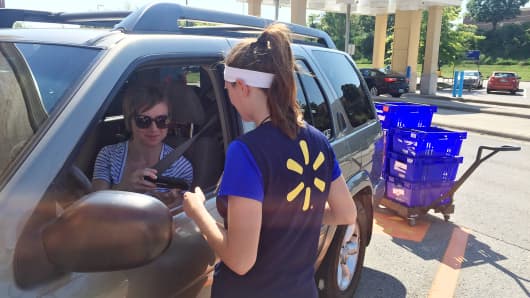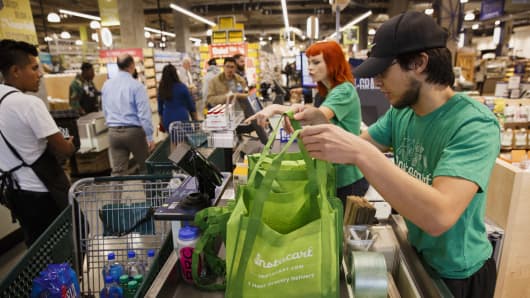Wal-Mart is 'best positioned' in online grocery battle against Amazon
CNBC.com
2.3K
SHARES

Sarah Halzack | The Washington Post | Getty Images
Ashley Green, 31, talks to a Walmart personal shopper as she retrieves her online grocery pickup order at the chain's Franklin, Tenn., location.
Wal-Mart Stores appears "best positioned" among the major food retailers to capitalize on the next phase of growth in online grocery and take on Amazon, according to a new report from Citi Research.
Kroger also scored high among the pure-play grocers in terms of its online grocery positioning compared with e-commerce giant Amazon, particularly as it related to pricing. But at the bottom of the list was Whole Foods Market.
Citi looked at the potential winners and losers in the online grocery space using a five-point analysis that looked at factors such as profitability, brick-and-mortar pricing, online pricing, exposure to Seattle-based Amazon, as well as any early adopter advantage.
"Based on our analysis, we determined that Wal-Mart was the winner (low exposure to Amazon Fresh/Prime Now markets and low EPS impact from exposure to those exposed markets)," Citi said in the 43-page report. "Whole Foods Market came in last place overall in our
analysis, largely due to their urban store exposure, which overlaps highly with Amazon Fresh and Prime Now, as well as their higher price points."
analysis, largely due to their urban store exposure, which overlaps highly with Amazon Fresh and Prime Now, as well as their higher price points."
Online grocery shopping could grow five-fold over the next decade, with American consumers spending upwards of $100 billion on food-at-home items by 2025, according an forecast released earlier this year by Food Marketing Institute and Nielsen.
While many of the large grocers are still testing and investing in different formats to see which one works best, there's no denying the changing demographics and rise of millennials weaned on digital technologies supports the case for significant future growth in online grocery spending.
Amazon's growing presence in the grocery space with different approaches highlights how much profit potential it sees in capturing spending from food and beverage sales. Amazon's grocery operating margin potential could be about 3 percent, or roughly comparable to North American retail industry margins, according to Citi. The estimate assumes inclusion of revenue from membership fees.
Amazon's prices on grocery items tend to be higher than Wal-Mart, which accounts for about 20 percent of grocery sales domestically. Citi's research found the price gap between Wal-Mart's store pick-up prices relative to AmazonFresh was an average of 30 percent.
Wal-Mart has been rapidly expanding its online grocery business and concentrating on the so-called click-and-collect model, which allows consumers to pickup orders at stores. A spokesman for the retailer told CNBC the retailer has expanded pickup to more than 100 markets in the U.S. last year and now has more than 600 locations offering the service.

Patrick T. Fallon | Bloomberg | Getty Images
InstaCart employees fulfill orders for delivery at the new Whole Foods Market Inc. store in downtown Los Angeles, California.
Whole Foods has partnered with Shipt for third-party grocery delivery and uses InstaCart too. Rival organic and natural foods chain Sprouts Farmers Market has an alliance with Amazon Prime Now.
According to Citi, Whole Foods has more than 60 percent of their stores overlapped with Amazon's current or future delivery markets while Wal-Mart is just 23 percent exposed. Sprouts also has a high overlap with Amazon delivery markets but given the partnership Citi said that "could therefore be a complementary, rather than adversarial scenario and could mute the threat, or even create an opportunity."
Yet Wal-Mart's exposure and threats from Amazon go well beyond groceries and include other merchandise categories, Citi noted. Similarly, Costco and Target also have online grocery activities through mostly third party services and compete with Amazon on several fronts such as consumer electronics, among other things.
As for Kroger, the Citi report found that in addition to its competitive pricing compared with Amazon that the Cincinnati-based grocer was poised to benefit from growth in online grocery due to its "early adopter advantage."
Even so, Kroger maybe seeing market share erosion in some markets against Wal-Mart, according to analysts. They believe part of the reason is the price-cutting strategy Wal-Mart embarked on to gain advantage against Kroger and Aldi, a rapidly expanding deep discounter.
"Kroger looks like they're losing share," said PiperJaffray analyst Sean Naughton. He explained that Kroger's same-store sales trends have been lagging Wal-Mart's in groceries.
Meantime, analysts suggest both Wal-Mart and Kroger are likely to continue expanding their "hybrid" online grocer model, which includes focusing on both click-and-collect or in-store pickup as well as utilizing third-party or direct delivery services.
"Both models are going to thrive in 2017 and 2018," said Diana Sheehan, director of retail insights for Kantar Retail. "I would actually predict that within 3 to 5 years — maybe sooner — that we would start to see some of these third parties getting acquired by major retailers."
Third-party home delivery services such as InstaCart, Shipt and Uber are expanding alliances with large national retail chains. The list of major retailers teaming with these services is growing and now includes not just traditional grocers such as Kroger and Whole Foods but warehouse club operators such as Costco. For example, Shipt this week announced it was offering Costco grocery deliveries in some Florida areas.
Sheehan said retailers partnered with the third-party delivery services are relying on them not just to deliver groceries but also be the face of the brand to shoppers. And she said it's doubtful that the "strongest-branded retailers" in the U.S. will allow this to happen for an extended period of time.
Still, some experts believe the grocery delivery model will ultimately work best for dense urban areas such as New York, a market where several pure-play grocery delivery companies such as FreshDirect have thrived.
"We're still in the test-and-learn phase," said Edward Yruma, an analyst with KeyBanc Capital Markets. He said the traditional grocery delivery model will continue to grow although Amazon's plans to open several brick-and-mortar grocery pickup locations maybe a sign that grocery shoppers prefer this approach over home delivery.
Yruma sees the grocery delivery model a lot like "waiting for the cable guy. You need to be at home between 5 and 8 o'clock versus just driving by a location and dumping groceries into the car [when you want it]."
Wal-Mart doesn't charge extra for online grocery orders picked up at stores, while rival Kroger offers a free trial but then charges after two deliveries. Kroger has been growing its online business with both its ClickList online grocery ordering service as well as providing grocery deliveries through third-party providers, including InstaCart, Shipt as well as conducting tests with Uber.
"Kroger is not wedded long term to charging a fee," said Wells Fargo analyst Zachary Fadem. "If they determined that is a competitive disadvantage then they could potentially change that. I don't necessarily think it hurts them to charge a fee right now because of the relatively solid results."
No comments:
Post a Comment